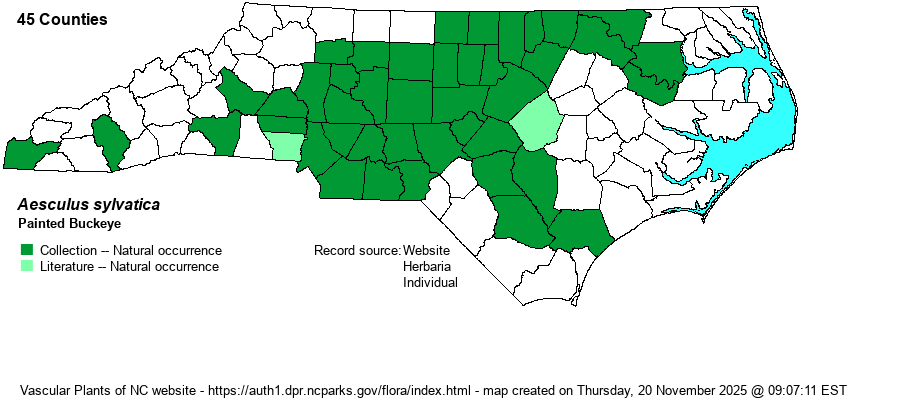| Author | Bartram | |
| Distribution | Throughout the eastern 2/3rds of the Piedmont and sparingly or locally in the western Coastal Plain, especially along the Roanoke and Cape Fear rivers in the latter province. It is sparingly found in the southwestern Piedmont and in the extreme southern Mountains. It has also been recorded from Pender County in the southeastern Coastal Plain.
This is primarily a species of the Piedmont province, ranging north only to southern VA, and southwest to central GA and central AL.
| |
| Abundance | Frequent to common in the Piedmont portion of the range, and also often common along the Roanoke River floodplain and adjacent slopes. Also can be locally numerous along the Cape Fear River well south into the Coastal Plain; very rare in Pender County. Very rare in the southwestern Piedmont and southern Mountains. | |
| Habitat | This species favors circumneutral (high pH) soil of rich forested slopes and bottomland forests, where found mainly on natural levees along brownwater rivers. It is a characteristic shrub of Basic Mesic Forests, when growing on slopes, but also occurs on some Mesic Mixed Hardwood Forest slopes. | |
| Phenology | Blooms from late March into early May, and fruits in July and August. Interestingly, this is one of the first woody species to produce leaves in spring, often in late February or early March; yet it usually drops its leaves before any other woody plant in late summer, often in August or by early September. | |
| Identification | This is a familiar species to persons walking in moist forests in the Piedmont, especially when looking for spring wildflowers. It is a large deciduous shrub to small tree, growing normally only to 10 feet but at times to 25-30 feet. It is essentially the only buckeye within its range, having the typical palmate leaves with five elliptical to oblanceolate leaflets growing to about 5 inches long. The flowers, in a terminal panicle, are light yellow, pinkish, greenish-yellow, or pinkish-yellow, and about 2 inches long; though not overly bright in color, they bloom early enough in spring that they are very obvious in the only partly vegetated forests at that time of year. Red Buckeye (A. pavia) may grow with it in a few places in the state (??), and unless you see red or pink petioles on the leaves of that species, or the flowers or buds, you may have to leave a plant unidentified. Reddish colored flowers of plants in the Cape Fear drainage from Bladen to Alamance County may represent former introgression from A. pavia, which no longer occurs there. Where the range barely overlaps the tree-sized Yellow Buckeye (A. flava), there can also be some uncertainty if the plant is of low stature and no fruits are available; Yellow Buckeye has quite a bit larger capsules (over 2 inches across). | |
| Taxonomic Comments | None
| |
| Other Common Name(s) | None | |
| State Rank | S5 | |
| Global Rank | G5 | |
| State Status | | |
| US Status | | |
| USACE-agcp | FAC link |
| USACE-emp | FAC link |

